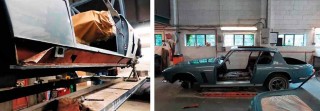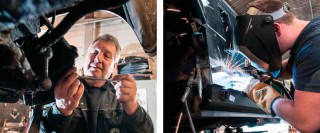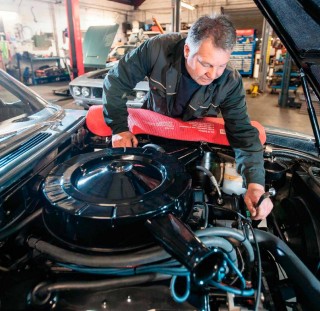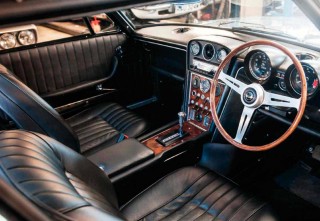I guess I would have been about ten years old,’ says Nick Whale. ‘This was in the early Seventies, watching the Parkinson chat show on Saturday night TV with my dad. Eric Morecambe was on, and he told a story about his first heart attack. He’d been performing in Leeds and on the way back from the show one night he pulled over with chest pains and had to ask a passer-by to drive him to hospital. The man was so excited to be driving a Jensen he failed to recognise the owner.’

It got a big laugh from the studio audience and Nick’s father said something that stuck in his son’s mind ever since. ‘That would be a good car to own one day.’
Nearly 40 years later Nick sold his motor group and got into the classic world when he established Silverstone Auctions. He’d always kept an eye out for the Morecambe Interceptor but now he was in a position to start hunting in earnest. By 2014 he’d tracked it down to a dealer in Belgium.
‘We went over to check the chassis numbers and provenance, and it really was Eric’s car. It looked okay though a restoration had been started and most of the repairs had been done poorly… I knew it would take a bit of work to correct.’

The car was entrusted to Britain’s longest-established Jensen specialist, Cropredy Bridge near Banbury in Oxfordshire. After a thorough inspection they came back with a list of faults. ‘We started off with a brief to do A, B, and C,’ says Nick. ‘It turned out we needed to do all that plus X, Y and Z and pretty much everything in between. The initial estimate was £50k-£60k… it ended up costing twice that.’
In fact, the rebuild got under way with a suspension upgrade – the necessity for major surgery only became apparent as more and more components were removed during the initial phases.
Cropredy’s Mike Bailey has been working on Jensens for decades. ‘We fitted the upgraded Fosse Way four-piston brake calipers and re-bushed absolutely everything,’ he says. This is a MkI Interceptor and these early models didn’t use a true double-wishbone arrangement at the front. Instead, they used lower wishbones, trunnions and an upper link with an Armstrong lever-type damper – the same arrangement as you’ll find on an MGB.’

The back axle also came out for refreshment, receiving new halfshafts. Curiously, getting the brake calipers to function as they should on an Interceptor is dependent on having sound chassis tubes – the offside tube, one of the pair that mount the engine and front suspension beam at their forward end, acts as a vacuum reservoir for the servo.
‘The tubes were okay,’ says Mike, ‘but there was a lot about the structure that wasn’t.’
Two words strike fear into many a Jensen owner: side beams. While the Interceptor may have those two huge tubes beneath, it doesn’t have a truly separate chassis and without strength in these sturdy side-members the cars can flop so much you can’t shut the doors after it’s been up on a two-post lift.
The construction could almost be designed to deceive MoT testers and prospective buyers into thinking all was well. Picture a hollow beam of thick steel in the sill, not quite square in cross-section because the inner face is deeper than the outer face. The inner face meets the floor, but the top, bottom and outer faces are hidden by an outer sill, a cosmetic sill cover and a shiny plate in the door aperture. The side beams can rot away while the outer sill remains intact.
‘The only easy way to test them is to poke a slim screwdriver into one of the drain holes in the outer sill,’ says Oliver Smith. ‘The point should hit something solid within half an inch or so. If it doesn’t…’
If it doesn’t, the whole lot must be cut away and replaced. To gain access to the full length of the beam the lower portion of both front and rear wings must be sliced out. Factor in re-instatement of the wings and outer sill and a lower-half respray and you’re looking at £7000 per side. Other remedial work such as the suspension and braking repairs means the bill for fixing an Interceptor chassis can be £20,000.

As more and more mistakes, bodges and decay came to light, Nick Whale was obliged to change the mission. ‘It would have been cheaper and quicker if the brief had been to strip it from the very beginning,’ he says. ‘But it had to be done right or not at all, so on we went.’ ‘The rear valance was full of filler and bathroom sealant,’ says body and paint specialist Dan Prewett.
‘You get used to the right shapes for various bits of the car, and these clearly weren’t right. When I started to investigate, I was shocked at what I found.’
This was even more of a bodge than the side beams. There, Prewett found repairs that had clearly been carried out to fix small areas bit by bit rather than doing the job properly. With much patient handforming of valance panels out of the way, Prewett could move on to the tailgate. This immense hemi-dome is the Interceptor’s USP as far as styling goes but it’s troublesome to repair – a great weight of glass is supported in a slim, doubleskinned steel frame.
‘Water runs down the tailgate and past the seal, resting in between the two skins,’ says Prewett. ‘I cut out the worst of it and bare-metalled the rest.’
With the centre section of the car taken care of during the involved beam replacement process, Prewett and his colleague Mick Hester found trouble up above. ‘It’s got a Webasto sunroof, and believe it or not they had a wooden frame around the edge,’ says Hester. ‘It was rotten and broken so we had to build a brand-new one from scratch. That took a lot of fiddling about.’

Another mission for Mick Hester was putting the engine bay right. ‘Think of the engine bay as a very cramped space in which two fans blow hot air over an Aga while a tin pot of petrol rests in the middle,’ says Oliver Smith. It can be tricky to get the Chrysler big-block to run as it should and to stop it slow-roasting the occupants. Both the cylinder heads were rebuilt – and everything else in the engine bay needed some kind of work doing. Those fans were replaced with more powerful and efficient Bosch items that demand such a draw of current they can stall engines with standard alternators. So in went an uprated alternator and a new radiator to make the most of the freshly increased airflow.
Keeping the heat where it should be is much easier with good thermal barriers. When new, Interceptor bulkheads were lined on the engine side with something Hester describes as ‘dodgy fibre matting’. He had the tedious job of scraping it all off until he was in a position to mount sheets of a modern multi-layer foil, several times more efficient than the original. A well-baked Carter AVS carburettor needed thorough reconditioning work.
Extreme underbonnet heat can boil the petrol in the carburettor and cook the wiring loom, though the wiring left much to be desired throughout the car.
‘Chris Dudley, our auto electrician, had a lot to do behind the centre console and dash,’ says Mike Bailey. ‘Chris is a great guy to have working on these cars, because he actually worked at the Jensen factory in West Bromwich. He doesn’t need a diagram – he can still remember all the wire colours!’
Meanwhile, Mick Hester was dealing with a seized heater fan that turned out to be full of leaves, a rebuilt servo to run the new brakes, a power steering pump and high-pressure lines that needed renewal and numerous small jobs from painting the air cleaner to locating a full set of coolant hoses.

The Interceptor’s transmission, the usually sturdy Chrysler Torqueflite 727 unit, also needed a rebuild. News from inside the car wasn’t much better – the original front seats had been re-trimmed badly and the rather tired rears left untouched. The only way to achieve a consistent look would be to re-trim the whole lot in new leather. But first, the body shell needed painting.
‘After all the body repairs were done, the last jobs I had to do before I could think about paint were gapping the doors and bonnet and marking any little dents I found,’ says Dan Prewett. With these tasks out of the way, Prewett primed the shell and began the laborious process of blocking it – sanding back with a block to create a consistent surface – and re-skimming where any low spots showed up. Finally the primer was ready for colour, in this case Crystal Blue, matched from an original sample found on a wheel. The final clear coat was cut back with 1200-grit discs.
‘The last step is to remove the 1200 sanding marks with an ultra-fine abrasive disc from 3M called Trizact, used wet,’ says Prewett. ‘After that it’s ready to polish.’ Except on the roof. The repairs to the Webasto frame had called for the removal of the old vinyl; and to apply a new covering the glue needed a surface to grip. So the paint in this area was sanded fairly coarsely to give a key, and with glue applied to both vinyl and bodyshell, the covering was laid on with utmost care.
All of this work was done with the glass removed. The car had arrived at Cropredy Bridge with the wrong glass all round – MkI Interceptors never wore tinted glass and the tailgates didn’t have the multiple demisting lines of later models, relying instead on a pair of ineffectual blowers. Details perhaps, but both Cropredy and their customer were committed to finishing the job with no corners cut.
Nick Whale’s unpleasant surprise following that initial phase of work meant that the car had already been with Cropredy for two or three months before mission creep moved it from something in for repair to a full-on restoration. If the target had been clear from day one, Oliver Smith estimates they could have been finished in nine months. Such things can be done when you work not just on one marque, but one model from one marque, almost exclusively. A 40-year collection of new and used spares, not to mention twice that in combined experience, also greases the wheel of progress.
That’s not to say they don’t still find challenges. During the fit-out of the interior, those hefty front seats had to come to bits for re-trimming but also for re-chroming of the hinges. The hinges themselves needed dismantling, a job Mick Hester recalls with an oath. He paints a vivid picture of tiny catches, levers and springs all leaping apart at once, making the correct order for reassembly a work of patient trial and error.

Hester’s work began with a carpet set and moved on to the fitting of the re-trimmed dash (including immaculately re-finished wood veneers), door cards and headlining. The seats, perfectly finished with new horsehair and black leather by Cropredy’s trimmer, should have been the final touch but once again fate intervened. Nick Whale is long of limb, and though he just about fitted in the car when the saggy old seats were in place, he couldn’t when the well-stuffed, restored versions arrived.
‘There are ways to accommodate taller drivers,’ says Hester. ‘The seat squab can be reduced in height but of course it’s better to do it before it’s retrimmed.’ Cheaper, too. But cost had to be sacrificed on the altar of correctness many times during the project.
‘Every time the phone rang and they said, “We’ve found something, and we could fix it this way or this more expensive way that would be better,” of course I said yes to the better option,’ says Whale. ‘It became a labour of love for me.’
While leafing through the car’s history file, he found correspondence between Eric Morecambe and Jensen’s managing director dating from 1970. Eric complains of the ‘rate of deterioration’ and a paint finish he found disappointing on a £4500 car. After much strife, Nick Whale now has the car Eric Morecambe thought he’d bought way back in 1968. Just as it should be, only better.
Thanks to: Nick Whale, Silverstone Auctions (silverstoneauctions.com), Matthew Watts and all at Cropredy Bridge Garage (cropredybridge.com).
Above: large sections of the double-skinned frame for that huge hemi-dome of glass had to be cut away and replaced.
Left: paint was treated with Trizact discs before final painting.
MY FAVOURITE TOOL
Oliver Smith: ‘On this job specifically, I think I would have to nominate the compression tester.
‘The positive readings that it registered when we assessed the car at the start of the restoration meant that this historic machine was going to be able to keep its original engine, which was a massive plus point for all concerned.’
High point
‘My family questioned the wisdom of the whole thing – they still do – but when the car was finished I knew we’d preserved a connection to a British icon’
Rotten wooden sunroof surround (yes, wooden) had to be remade.
Seats had to be retrimmed a second time after lofty owner Nick Whale couldn’t fit in.
‘Think of the engine bay as a cramped space in which two fans blow hot air over an Aga with a pot of petrol in the middle’
The first job was merely upgrading the suspension. Then the horrors revealed themselves.
Sills hide the side beams, and if these are rotten it’s time for major surgery.
Low point
‘Revealing the side beams and discovering the patchwork quilt of old repairs that meant complete renewal – and much greater expense – was unavoidable’. Previous restoration efforts has to be redone, properly.





